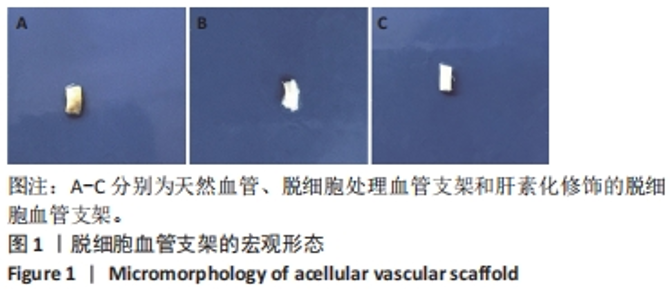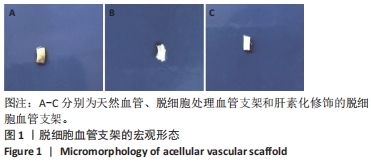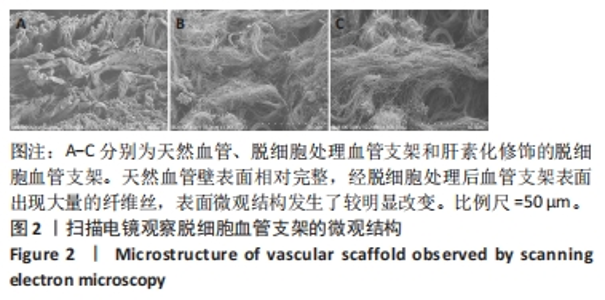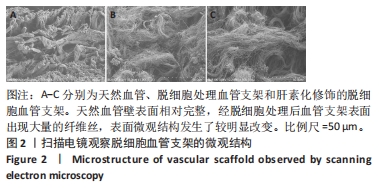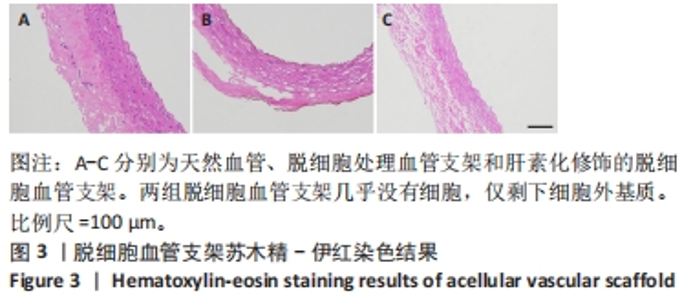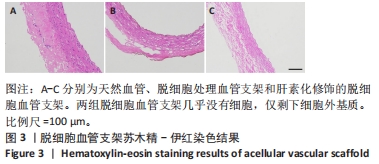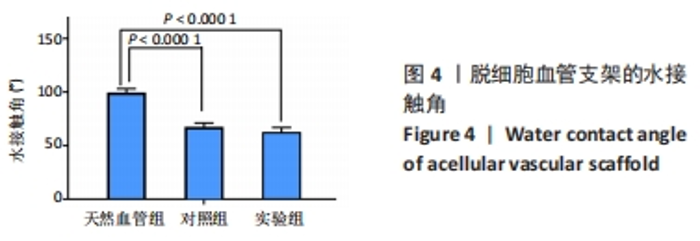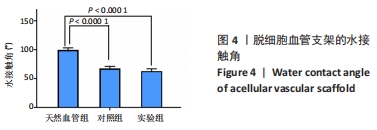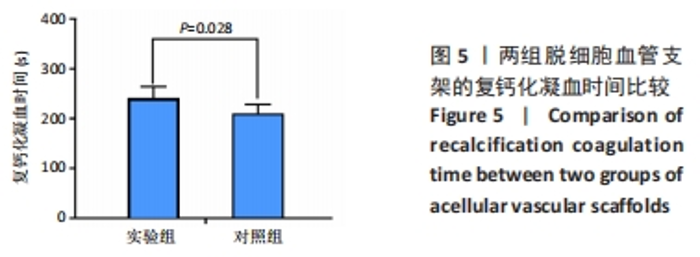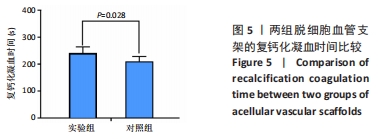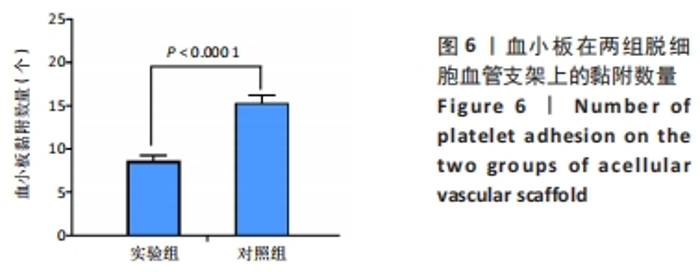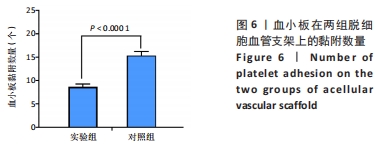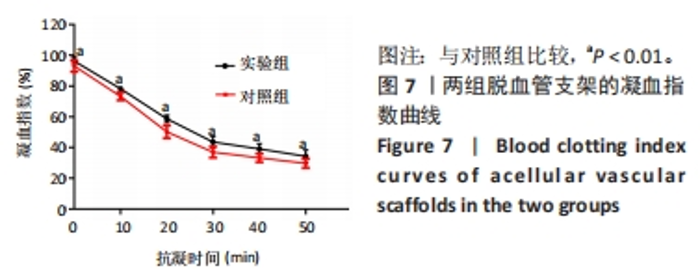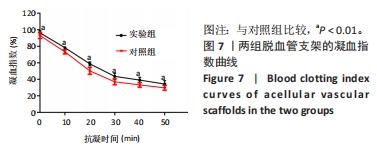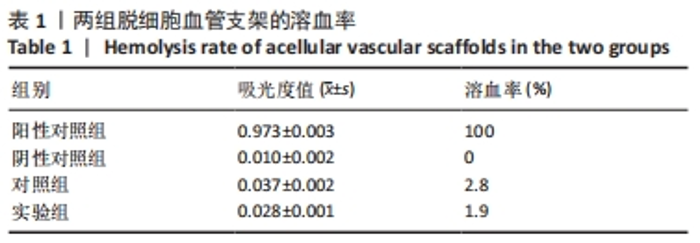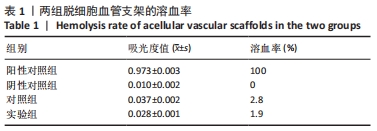Chinese Journal of Tissue Engineering Research ›› 2024, Vol. 28 ›› Issue (17): 2631-2636.doi: 10.12307/2024.479
Previous Articles Next Articles
Preparation of heparinized acellular vascular scaffold and hemocompatibility evaluation
Li Xiafei1, Zhao Lingling2, Liang Feng3, Zhang Xuewei2, Zhang Jinjin2, Lin Fei4, Yang Tuo2, Zhao Liang2
- 1College of Medical Engineering, 2College of Life Science and Technology, 3Mingde College, Xinxiang Medical University, Xinxiang 453003, Henan Province, China; 4First Affiliated Hospital of Xinxiang Medical University, Xinxiang 453003, Henan Province, China
-
Received:2023-07-07Accepted:2023-09-15Online:2024-06-18Published:2023-12-14 -
Contact:Zhao Liang, PhD, Associate professor, College of Life Science and Technology, Xinxiang Medical University, Xinxiang 453003, Henan Province, China -
About author:Li Xiafei, Master, Experimentalist, College of Medical Engineering, Xinxiang Medical University, Xinxiang 453003, Henan Province, China -
Supported by:Natural Science Foundation of Henan Province, No. 202300410311 (to ZL); College Student Innovation and Entrepreneurship Training Program Project of Henan Province, No. S202310472023 (to LF); Postgraduate Research and Innovation Support Plan Project of Xinxiang Medical University, No. YJSCX2022108Y (to YT); 2022 Research and Innovation of College Students in Xinxiang Medical University, No. xyxskyz202236 (to ZJJ); Employment and Entrepreneurship Project in Colleges and Universities in Henan Province, No. JYB2023039 (to ZL)
CLC Number:
Cite this article
Li Xiafei, Zhao Lingling, Liang Feng, Zhang Xuewei, Zhang Jinjin, Lin Fei, Yang Tuo, Zhao Liang. Preparation of heparinized acellular vascular scaffold and hemocompatibility evaluation[J]. Chinese Journal of Tissue Engineering Research, 2024, 28(17): 2631-2636.
share this article
Add to citation manager EndNote|Reference Manager|ProCite|BibTeX|RefWorks
| [1] AWAD N K, NIU H, ALI U, et al. Electrospun fibrous scaffolds for small-diameter blood vessels: a review. Membranes (Basel). 2018;8(1):15. [2] JI J, XU H, LI C, et al. Small-Caliber Tissue-Engineered Vascular Grafts Based on Human-Induced Pluripotent Stem Cells: Progress and Challenges. Tissue Eng Part B Rev. 2023;29(4):441-455. [3] FLIS A, TRÁVNÍČKOVÁ M, KOPER F, et al. Poly(octamethylene citrate) Modified with Glutathione as a Promising Material for Vascular Tissue Engineering. Polymers (Basel). 2023;15(5):1322. [4] PASHNEH-TALA S, MACNEIL S, CLAEYSSENS F. The tissue-engineered vascular graft-past, present, and future. Tissue Eng Part B Rev. 2016; 22(1):68-100. [5] MOHAMMADI F, GOLAFSHAN N, KHARAZIHA M, et al. Chitosan-heparin nanoparticle coating on anodized NiTi for improvement of blood compatibility and biocompatibility. Int J Biol Macromol. 2019;127: 159-168. [6] ZIZHOU R, WANG X, HOUSHYAR S. Review of Polymeric Biomimetic Small-Diameter Vascular Grafts to Tackle Intimal Hyperplasia. ACS Omega. 2022;7:22125-22148. [7] ZHANG F, KING MW. Immunomodulation Strategies for the Successful Regeneration of a Tissue-Engineered Vascular Graft. Adv Healthc Mater. 2022;11:e2200045. [8] OBIWELUOZOR FO, KAYUMOV M, KWAK Y, et al. Rapid remodeling observed at mid-term in-vivo study of a smart reinforced acellular vascular graft implanted on a rat model. J Biol Eng. 2023;17:1. [9] 刘俊,张晓膺.纳米APS外膜肝素化内膜小口径组织工程血管的实验研究[J].上海交通大学学报(医学版),2017,37(3):337-343. [10] NEMENO-GUANZON JG, LEE S, BERG JR, et al. Trends in tissue engineering for blood vessels. J Biomed Biotechnol. 2012;2012: 956345. [11] YAO Y, ZAW AM, ANDERSON DEJ, et al. Fucoidan and topography modification improved in situ endothelialization on acellular synthetic vascular grafts. Bioact Mater. 2023;22:535-550. [12] BAHRAMZADEH E, YILMAZ E, ADALI T. Chitosan-graft-poly(N-hydroxy ethyl acrylamide) copolymers: Synthesis, characterization and preliminary blood compatibility in vitro. Int J Biol Macromol. 2019;123:1257-1266. [13] 夏成勇,刘长建,冉峰,等.等离子体处理脱细胞血管支架的血液相容性[J].中国组织工程研究与临床康复,2009,13(21):4033-4036. [14] DU PC, LI XF, SUN LL, et al. Improved hemocompatibility by modifying acellular blood vessels with bivalirudin and its biocompatibility evaluation. J Biomed Mater Res A. 2022;110(3):635-651. [15] KOPEC K, WOJASINSKI M, EICHLER M, et al. Polydopamine and gelatin coating for rapid endothelialization of vascular scaffolds. Biomater Adv. 2022;134:112544. [16] TARDALKAR K, MARSALE T, BHAMARE N, et al. Heparin Immobilization of Tissue Engineered Xenogeneic Small Diameter Arterial Scaffold Improve Endothelialization. Tissue Eng Regen Med. 2022;19:505-523. [17] YANG F, GUO G, WANG Y. Inflammation-triggered dual release of nitroxide radical and growth factor from heparin mimicking hydrogel-tissue composite as cardiovascular implants for anti-coagulation, endothelialization, anti-inflammation, and anti-calcification. Biomaterials. 2022;289:121761. [18] LV YM, HUANG HM, WANG QL, et al. Acellular porcine aorta matrix as a novel tissue engineered vascular scaffold biocompatibility and mechanical properties. J Cli Reh Tissue Eng Res. 2010;14(47):8921-8925. [19] QIU H, QI P, LIU J, et al. Biomimetic engineering endothelium-like coating on cardiovascular stent through heparin and nitric oxide-generating compound synergistic modification strategy. Biomaterials. 2019;207:10-22. [20] 周莹,肖利吉,姚丽,等.自修复型超疏水材料研究进展[J].材料导报,2019,33(7):159-167. [21] 高云佳,赵庆春,闵鹏,等.脱皮马勃止血有效部位的实验研究[J].解放军药学学报,2010,26(6):82-84. [22] 高娟.壳聚糖止血活性及其作用机理的初步研究[D].无锡:江南大学,2009. [23] 秦静雯,王鸿博,傅佳佳,等.醋纤基载药纳米纤维药物活性评价[J].功能材料,2014,45(14):14077-14080. [24] 欧阳晨曦,李沁,王维慈,等.小口径人工血管血液相容性[J].中国组织工程研究与临床康复,2008,12(6):133-137. [25] LIU HF, LI XM, ZHOU G, et al. Electrospun sulfated silk fibroin nanofibrous scaffolds for vascular tissue engineering. Biomaterials. 2011;32:3784-3793. [26] 陈捷,杨镜秋,刘春晓.灌注法制备全肾脏脱细胞基质支架的体内生物相容性[J].中国组织工程研究,2015,19(16):75-79. [27] 薛正翔,陈登龙,李敏,等.静电纺丝制备小直径血管支架及其血液相容性的研究[J].功能材料,2009(10):129-132. [28] 马慧.羟基磷灰石表面构建压电陶瓷涂层的生物相容性研究[D].乌鲁木齐:新疆医科大学,2015. [29] 贾山山,陈群清,闫玉生.肝素在人工小血管表面改性中的应用[J].中国医学物理学杂志,2018,35(10):126-130. [30] 马巧,宋文静,冀慧雁,等.血管支架材料的应用及研究现状[J].临床医药实践,2018,27(11):57-62. [31] 阮烨.冷空气活动对心脑血管疾病相关指标影响的初步研究[D].兰州:兰州大学,2013. [32] SU H, LIU W, LI X, et al. Cellular energy supply for promoting vascular remodeling of small-diameter vascular grafts: a preliminary study of a new strategy for vascular graft development. Biomater Sci. 2023; 11(9):3197-3213. [33] OMID H, ABDOLLAHI S, BONAKDAR S, et al. Biomimetic vascular tissue engineering by decellularized scaffold and concurrent cyclic tensile and shear stresses. J Mater Sci Mater Med. 2023;34:12. [34] 刘桂阳.皮/芯结构的丝素/聚己内酯纤维及其双层血管再生支架[D].苏州:苏州大学,2015. [35] YAO Y, WANG J, CUI Y, et al. Effect of sustained heparin release from PCL/chitosan hybrid small-diameter vascular grafts on anti-thrombogenic property and endothelialization. Acta Biomater. 2014; 10(6):2739-2749. [36] 赵亮,李霞飞,李成成,等.应用Triton-x100加丹参酚酸B制备脱细胞血管支架及其血液相容性研究[J].中国生物医学工程学报, 2019,38(2):201-207. [37] LIU H, LI X, ZHOU G, et al. Electrospun sulfated silk fibroin nanofibrous scaffolds for vascular tissue engineering. Biomaterials. 2011;32(15): 3784-3793. [38] MONTELIONE N, LORENI F, NENNA A, et al. Tissue Engineering and Targeted Drug Delivery in Cardiovascular Disease: The Role of Polymer Nanocarrier for Statin Therapy. Biomedicines. 2023;11(3):798. [39] LIU Y, YUAN H, LIU Y, et al. Multifunctional nanoparticle-VEGF modification for tissue-engineered vascular graft to promote sustained anti-thrombosis and rapid endothelialization. Front Bioeng Biotechnol. 2023;11:1109058. [40] 王学宁,陈长志,杨岷,等.肝素处理小口径脱细胞异种血管的移植研究[J].中华胸心血管外科杂志,2006,22(5):324-325. |
| [1] | Yang Yufang, Yang Zhishan, Duan Mianmian, Liu Yiheng, Tang Zhenglong, Wang Yu. Application and prospects of erythropoietin in bone tissue engineering [J]. Chinese Journal of Tissue Engineering Research, 2024, 28(9): 1443-1449. |
| [2] | Chen Kaijia, Liu Jingyun, Cao Ning, Sun Jianbo, Zhou Yan, Mei Jianguo, Ren Qiang. Application and prospect of tissue engineering in treatment of osteonecrosis of the femoral head [J]. Chinese Journal of Tissue Engineering Research, 2024, 28(9): 1450-1456. |
| [3] | Mei Jingyi, Liu Jiang, Xiao Cong, Liu Peng, Zhou Haohao, Lin Zhanyi. Proliferation and metabolic patterns of smooth muscle cells during construction of tissue-engineered blood vessels [J]. Chinese Journal of Tissue Engineering Research, 2024, 28(7): 1043-1049. |
| [4] | Wang Shanshan, Shu Qing, Tian Jun. Physical factors promote osteogenic differentiation of stem cells [J]. Chinese Journal of Tissue Engineering Research, 2024, 28(7): 1083-1090. |
| [5] | Shen Ziqing, Xia Tian, Shan Yibo, Zhu Ruijun, Wan Haoxin, Ding Hao, Pan Shu, Zhao Jun. Vascularized tracheal substitutes constructed by exosome-load hydrogel-modified 3D printed scaffolds [J]. Chinese Journal of Tissue Engineering Research, 2024, 28(5): 697-705. |
| [6] | Zhu Liwei, Wang Jiangyue, Bai Ding. Application value of nanocomposite gelatin methacryloyl hydrogels in different bone defect environments [J]. Chinese Journal of Tissue Engineering Research, 2024, 28(5): 753-758. |
| [7] | Chen Xiaofang, Zheng Guoshuang, Li Maoyuan, Yu Weiting. Preparation and application of injectable sodium alginate hydrogels [J]. Chinese Journal of Tissue Engineering Research, 2024, 28(5): 789-794. |
| [8] | Wang Jiani, Chen Junyu. Angiogenesis mechanism of metal ions and their application in bone tissue engineering [J]. Chinese Journal of Tissue Engineering Research, 2024, 28(5): 804-812. |
| [9] | Yang Yuqing, Chen Zhiyu. Role and application of early transient presence of M1 macrophages in bone tissue engineering [J]. Chinese Journal of Tissue Engineering Research, 2024, 28(4): 594-601. |
| [10] | Kong Xiangyu, Wang Xing, Pei Zhiwei, Chang Jiale, Li Siqin, Hao Ting, He Wanxiong, Zhang Baoxin, Jia Yanfei. Biological scaffold materials and printing technology for repairing bone defects [J]. Chinese Journal of Tissue Engineering Research, 2024, 28(3): 479-485. |
| [11] | Xu Jing, Lyu Huixin, Bao Xin, Zhang Yi, Wang Yihan, Zhou Yanmin. Application of near infrared responsive hydrogels in tissue engineering [J]. Chinese Journal of Tissue Engineering Research, 2024, 28(3): 486-492. |
| [12] | Gu Mingxi, Wang Changcheng, Tian Fengde, An Ning, Hao Ruihu, Guo Lin. Preparation and in vitro evaluation of a three-dimensional porous cartilage scaffold made of silk fibroin/gelatin/chitosan [J]. Chinese Journal of Tissue Engineering Research, 2024, 28(3): 366-372. |
| [13] | Wang Xinmin, Yan Wenkai, Song Yahui, Liu Fei. Leukocyte- and platelet-rich fibrin with autologous hamstring tendon for traumatic patella dislocation [J]. Chinese Journal of Tissue Engineering Research, 2024, 28(3): 404-410. |
| [14] | Bi Yujie, Ma Dujun, Peng Liping, Zhou Ziqiong, Zhao Jing, Zhu Houjun, Zhong Qiuhui, Yang Yuxin. Strategy and significance of Chinese medicine combined with medical hydrogel for disease treatment [J]. Chinese Journal of Tissue Engineering Research, 2024, 28(3): 419-425. |
| [15] | Wang Xinyi, Xie Xianrui, Chen Yujie, Wang Xiaoyu, Xu Xiaoqing, Shen Yihong, Mo Xiumei. Electrospun nanofiber scaffolds for soft and hard tissue regeneration [J]. Chinese Journal of Tissue Engineering Research, 2024, 28(3): 426-432. |
| Viewed | ||||||
|
Full text |
|
|||||
|
Abstract |
|
|||||
